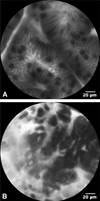Real-time increased detection of neoplastic tissue in Barrett's esophagus with probe-based confocal laser endomicroscopy: final results of an international multicenter, prospective, randomized, controlled trial
- PMID: 21741642
- PMCID: PMC3629729
- DOI: 10.1016/j.gie.2011.04.004
Real-time increased detection of neoplastic tissue in Barrett's esophagus with probe-based confocal laser endomicroscopy: final results of an international multicenter, prospective, randomized, controlled trial
Abstract
Background: Probe-based confocal laser endomicroscopy (pCLE) allows real-time detection of neoplastic Barrett's esophagus (BE) tissue. However, the accuracy of pCLE in real time has not yet been extensively evaluated.
Objective: To compare the sensitivity and specificity of pCLE in addition to high-definition white-light endoscopy (HD-WLE) with HD-WLE alone for the detection of high-grade dysplasia (HGD) and early carcinoma (EC) in BE.
Design: International, prospective, multicenter, randomized, controlled trial.
Setting: Five tertiary referral centers.
Patients: A total of 101 consecutive BE patients presenting for surveillance or endoscopic treatment of HGD/EC.
Interventions: All patients were examined by HD-WLE, narrow-band imaging (NBI), and pCLE, and the findings were recorded before biopsy samples were obtained. The order of HD-WLE and NBI was randomized and performed by 2 independent, blinded endoscopists. All suspicious lesions on HD-WLE or NBI and 4-quadrant random locations were documented. These locations were examined by pCLE, and a presumptive diagnosis of benign or neoplastic (HGD/EC) tissue was made in real time. Finally, biopsies were taken from all locations and were reviewed by a central pathologist, blinded to endoscopic and pCLE data.
Main outcome measurements: Diagnostic characteristics of pCLE.
Results: The sensitivity and specificity for HD-WLE were 34.2% and 92.7%, respectively, compared with 68.3% and 87.8%, respectively, for HD-WLE or pCLE (P = .002 and P < .001, respectively). The sensitivity and specificity for HD-WLE or NBI were 45.0% and 88.2%, respectively, compared with 75.8% and 84.2%, respectively, for HD-WLE, NBI, or pCLE (P = .01 and P = .02, respectively). Use of pCLE in conjunction with HD-WLE and NBI enabled the identification of 2 and 1 additional HGD/EC patients compared with HD-WLE and HD-WLE or NBI, respectively, resulting in detection of all HGD/EC patients, although not statistically significant.
Limitations: Academic centers with enriched population.
Conclusions: pCLE combined with HD-WLE significantly improved the ability to detect neoplasia in BE patients compared with HD-WLE. This may allow better informed decisions to be made for the management and subsequent treatment of BE patients. (
Clinical trial registration number: NCT00795184.).
Copyright © 2011 American Society for Gastrointestinal Endoscopy. Published by Mosby, Inc. All rights reserved.
Figures


Comment in
-
Probe-based confocal endomicroscopy in Barrett's esophagus: the real deal or another tease?Gastrointest Endosc. 2011 Sep;74(3):473-6. doi: 10.1016/j.gie.2011.05.046. Gastrointest Endosc. 2011. PMID: 21872706 No abstract available.
References
-
- Pohl H, Welch HG. The role of overdiagnosis and reclassification in the marked increase of esophageal adenocarcinoma incidence. J Natl Cancer Inst. 2005;97:142–146. - PubMed
-
- Guelrud M, Herrera I, Essenfeld H, et al. Enhanced magnification endoscopy: a new technique to identify specialized intestinal metaplasia in Barrett’s esophagus. Gastrointest Endosc. 2001;53:559–565. - PubMed
-
- Sharma P, Bansal A, Mathur S, et al. The utility of a novel narrow band imaging endoscopy system in patients with Barrett’s esophagus. Gastrointest Endosc. 2006;64:167–175. - PubMed
-
- Lim CH, Rotimi O, Dexter SP, et al. Randomized crossover study that used methylene blue or random 4-quadrant biopsy for the diagnosis of dysplasia in Barrett’s esophagus. Gastrointest Endosc. 2006;64:195–199. - PubMed
Publication types
MeSH terms
Associated data
Grants and funding
LinkOut - more resources
Full Text Sources
Medical

